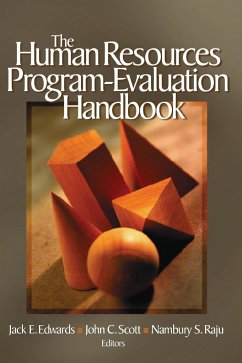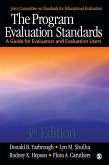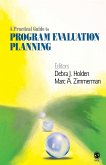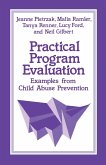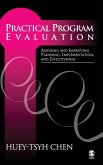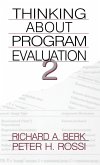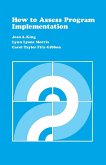- Gebundenes Buch
- Merkliste
- Auf die Merkliste
- Bewerten Bewerten
- Teilen
- Produkt teilen
- Produkterinnerung
- Produkterinnerung
The Human Resources Program-Evaluation Handbook is the first book to present state-of-the-art procedures for evaluating and improving human resources programs. Editors Jack E. Edwards, John C. Scott, and Nambury S. Raju provide a user-friendly yet scientifically rigorous "how to" guide to organizational program-evaluation. Integrating perspectives from a variety of human resources and organizational behavior programs, a wide array of contributing professors, consultants, and governmental personnel successfully link scientific information to practical application. Designed for academics and…mehr
Andere Kunden interessierten sich auch für
![The Program Evaluation Standards The Program Evaluation Standards]() Donald B. YarbroughThe Program Evaluation Standards165,99 €
Donald B. YarbroughThe Program Evaluation Standards165,99 €![A Practical Guide to Program Evaluation Planning A Practical Guide to Program Evaluation Planning]() Debra J. HoldenA Practical Guide to Program Evaluation Planning105,99 €
Debra J. HoldenA Practical Guide to Program Evaluation Planning105,99 €![Practical Program Evaluation Practical Program Evaluation]() Jeanne PietrzakPractical Program Evaluation105,99 €
Jeanne PietrzakPractical Program Evaluation105,99 €![Practical Program Evaluation Practical Program Evaluation]() Huey T. ChenPractical Program Evaluation150,99 €
Huey T. ChenPractical Program Evaluation150,99 €![Thinking about Program Evaluation Thinking about Program Evaluation]() Richard A. BerkThinking about Program Evaluation165,99 €
Richard A. BerkThinking about Program Evaluation165,99 €![How to Assess Program Implementation How to Assess Program Implementation]() Jean A. KingHow to Assess Program Implementation75,99 €
Jean A. KingHow to Assess Program Implementation75,99 €![The Sage Handbook of Methods in Social Psychology The Sage Handbook of Methods in Social Psychology]() Carol SansoneThe Sage Handbook of Methods in Social Psychology194,99 €
Carol SansoneThe Sage Handbook of Methods in Social Psychology194,99 €-
-
-
The Human Resources Program-Evaluation Handbook is the first book to present state-of-the-art procedures for evaluating and improving human resources programs. Editors Jack E. Edwards, John C. Scott, and Nambury S. Raju provide a user-friendly yet scientifically rigorous "how to" guide to organizational program-evaluation. Integrating perspectives from a variety of human resources and organizational behavior programs, a wide array of contributing professors, consultants, and governmental personnel successfully link scientific information to practical application. Designed for academics and graduate students in industrial-organizational psychology, human resources management, and business, the handbook is also an essential resource for human resources professionals, consultants, and policy makers.
Hinweis: Dieser Artikel kann nur an eine deutsche Lieferadresse ausgeliefert werden.
Hinweis: Dieser Artikel kann nur an eine deutsche Lieferadresse ausgeliefert werden.
Produktdetails
- Produktdetails
- Verlag: Sage Publications, Inc
- Seitenzahl: 600
- Erscheinungstermin: 22. Juli 2003
- Englisch
- Abmessung: 260mm x 183mm x 36mm
- Gewicht: 1308g
- ISBN-13: 9780761923961
- ISBN-10: 0761923969
- Artikelnr.: 21726030
- Herstellerkennzeichnung
- Libri GmbH
- Europaallee 1
- 36244 Bad Hersfeld
- gpsr@libri.de
- Verlag: Sage Publications, Inc
- Seitenzahl: 600
- Erscheinungstermin: 22. Juli 2003
- Englisch
- Abmessung: 260mm x 183mm x 36mm
- Gewicht: 1308g
- ISBN-13: 9780761923961
- ISBN-10: 0761923969
- Artikelnr.: 21726030
- Herstellerkennzeichnung
- Libri GmbH
- Europaallee 1
- 36244 Bad Hersfeld
- gpsr@libri.de
In addition to editing this book, Jack Edwards has published two survey books cited in the Recommended Readings section of this chapter. He is currently an Assistant Director in the Office of Applied Research and Methods at the U.S. General Accounting Office, Washington, DC. His prior positions include Chief of the Personnel Survey Branch at the Defense Manpower Data Center and tenured Associate Professor at the Illinois Institute of Technology. (The opinions expressed in this article are those of the authors and do not necessarily reflect the views of the U.S. General Accounting Office.)
Preface
Part I: Framework for Human Resources Program Evaluation
CHAPTER 1: OVERVIEW OF PROGRAM EVALUATION - Dale S. Rose, E. Jane Davidson
Program Evaluation in Human Resources Evaluation Myths
Key Distinctions
Who Does Program Evaluation?
Choosing Criteria for Success
Practical Design Considerations
Costs and Benefits
Utilization
CHAPTER 2: JOB ANALYSIS-THE BASIS FOR DEVELOPING CRITERIA FOR ALL HUMAN
RESOURCES PROGRAMS - Peter Y. Chen, Jeanne Carsten, Autumn D. Krauss
Uses of a Proactive Job Analysis Program
Assessing the Need for a Job Analysis Program and Preparing for It
Conducting a Job Analysis Program
CHAPTER 3: CRITERIA FOR HUMAN RESOURCES PROGRAM EVALUATION - Stephen David
Steinhaus, L. A. Witt
Common Approaches and Pitfalls
Characteristics of Good Criteria
Practical Steps in Criterion Development and Implementation
Part II: Staffing
CHAPTER 4: RECRUITMENT - Michael M. Harris, Elliot D. Lasson
Understanding the Recruitment Process Recruitment Sources Understanding the
Recruitment Process Recruitment Sources
Evaluating the Recruitment Function
CHAPTER 5: SETTING STANDARDS - Andrew J. Falcone, Nambury S. Raju
Setting Standards for Program Evaluation
Evaluation of the Standard-Setting Programs
Standard-Setting Procedures
CHAPTER 6: EVALUATING PERSONNEL SELECTION SYSTEMS - Scott B. Morris,
Russell Lobsenz
Program Evaluation Process
Reliability
Interpreting Reliability
Validity
Test Administration Practices
Fairness, Bias, and Discrimination Bias
Utility Analysis
CHAPTER 7: SELECTING MANAGERS AND EXECUTIVES: THE CHALLENGE OF MEASURING
SUCCESS - Rob Silzer, Seymour Adler
Selection Context
Evaluating Selection Design
Evaluating Selection Administration
Evaluating Selection Decisions
Evaluating Selection Outcomes
Part III: Evaluating and Rewarding Employees
CHAPTER 8: PERFORMANCE APPRAISAL AND FEEDBACK PROGRAMS - Janet L.
Barnes-Farrell, Angela M. Lynch
Goals of Appraisal and Feedback Systems
Functions of Performance Appraisal
Evaluating Performance Appraisal Measurement Functions
Evaluating the Communications Function of Performance Appraisal
CHAPTER 9: THE EVALUATION OF 360-DEGREE FEEDBACK PROGRAMS - John C. Scott,
Manuel London
An Overview of 360-Degree Feedback
Criteria for Evaluating 360-Degree Feedback
Methods for Evaluating the Quality of the 360-Degree Program
Evaluators of the Survey Program
Evaluating the Quality and Long-term Effects of 360-Degree Feedback
Longitudinal Study
CHAPTER 10: COMPENSATION ANALYSIS - Mary D. Baker
Who Should Be Involved in the Preparation of Compensation Analysis?
Pay Elements Included in a Compensation Study
Methods of Analyzing Compensation
Complex Pay Equity Techniques-Multiple Regression Analysis
Explanatory Factors
Tainted Variables
Part IV: Employee Effectiveness
CHAPTER 11: CONDUCTING TRAINING EVALUATION - Miguel A. Quiñones, Scott
Tonidandel
Overview of Training Evaluation
A 5-Step Model of Training Evaluation
CHAPTER 12: SUCCESSION MANAGEMENT - Michael M. Harris, Manuel London,
William C. Byham, Marilyn Buckner
What Is Succession Management?
Methods for Evaluating Competencies
Determining Appropriate Developmental Activities
Role of the CEO
Line Manager Involvement
Identifying the Organizational Level to Be the Target of the Succession
Management Process and the Current and Future Requirements
Selection Decisions
Evaluating Succession Management
A Case Example
CHAPTER 13: A PRACTICAL GUIDE TO EVALUATING COACHING: TRANSLATING
STATE-OF-THE-ART TECHNIQUES TO THE REAL WORLD - David B. Peterson, Kurt
Kraiger
Research on Coaching
Challenges and Issues in Evaluating Coaching
A Practical Guide to Evaluating Coaching
Part V: Team and Organizational Effectiveness
CHAPTER14: TEAM PERFORMANCE - Wendy S. Becker, John E. Mathieu
Performance Evaluation as a General Process
Measurement Framework for Understanding Team Performance
Getting Started: How to Develop Team Performance Measures
Sources of Measurement in Teams
The Future of Team Performance Evaluation
CHAPTER 15: THE EVALUATION OF JOB REDESIGN PROCESSES - Steven F. Cronshaw,
Sidney A. Fine
Five Principles of Job Redesign Evaluation
Worker Criteria for the Evaluation of Job Redesign Programs
Management Criteria for the Evaluation of Job Redesign Programs
The Summative Evaluation of Job Redesign
Bringing Together Worker and Management Criteria in Successful Job Redesign
CHAPTER 16: ORGANIZATION DEVELOPMENT - Allan H. Church
Overview of Organization Development
A Process for Evaluating OD Interventions
Case Examples
CHAPTER 17: EVALUATING DIVERSITY PROGRAMS - Paul Rosenfeld, Dan Landis,
David Dalsky
Evaluating Diversity Programs: Barriers and Benefits
Evaluating Diversity Programs: A 6-Step Plan
Part VI: Organizational Communications
CHAPTER 18: EVALUATING ORGANIZATIONAL SURVEY PROGRAMS - Jack E. Edwards,
Bruce M. Fisher
Methods for Gathering Evaluation Data
Evaluators of the Survey Program
Criteria for Judging Survey Program Quality
CHAPTER 19: A PRACTICAL GUIDE TO EVALUATING COMPUTER-ENABLED COMMUNICATIONS
- J. Philip Craiger, Virginia Collins, Alex Nicoll
Dimensions of Communication Technologies
Evaluating Corporate Needs
Strategies for Selecting Among a Set of Alternatives
Prevalent Communication Technologies
Computer-Enabled Communication: Impact and Policies
CHAPTER 20: CUSTOMER SERVICE PROGRAMS - L. A. Witt, Paulette Henry,
Margareta Emberger
The Role of Human Resources in Customer Service
Identifying Stakeholders (Who)
Selecting the Evaluation Criteria (What)
Linking HR Programs with Customer Service Outcomes (Why)
Part VII: Health and Work/Life Balance
CHAPTER 21: HEALTH AND SAFETY TRAINING PROGRAMS - Michael J. Burke, Jill
Bradley, Harold N. Bowers
A Systems Approach to Health and Safety Training
Measures of Health and Safety Training Program Effectiveness
Guidelines for Assessing On-the-Job Behavior (STEP-3) Associated with
Health and Safety Training
Issues Concerning the Transfer of Health and Safety Training
CHAPTER 22: WORK/LIFE BALANCE POLICIES AND PROGRAMS - E. Jeffrey Hill, Sara
P. Weiner
Introduction: Why Evaluate Work/Life Policies and Programs?
Historical Overview
Evaluating Work/Life Policies and Programs
CHAPTER 23: EVALUATION OF HUMAN RESOURCE INFORMATION SYSTEMS - Jeffrey M.
Stanton, Timothy V. Nolan, John R. Dale
Brief Historical Overview of HRISs
Primary Research Strategies for Evaluating an HRIS
Assessors Who Can Conduct HRIS Evaluations
Criteria for Judging HRIS Quality
Integrating Criteria and Reporting Evaluation Results
CHAPTER 24: GLOBAL HUMAN RESOURCE METRICS - Helen De Cieri, John Boudreau
Talentship: A Decision Science for HR
A Strategic Approach to the Measurement of Global HR
A Model for Global HR Metrics
CHAPTER 25: STRATEGIC PLANNING FOR HUMAN RESOURCES - Edward J. Kelleher, F.
Stephen Cobe
Key Strategic Planning Issues for HR
The Strategic Planning-HR Interface
HR Roles in the Strategic Management Process
Evaluation of HR Strategy
Glossary: Definitions of Technical and Statistical Terms Commonly Used in
HR Program Evaluations - Chet Robie and Nambury S. Raju
Index
About the Editor
About the Contributors
Part I: Framework for Human Resources Program Evaluation
CHAPTER 1: OVERVIEW OF PROGRAM EVALUATION - Dale S. Rose, E. Jane Davidson
Program Evaluation in Human Resources Evaluation Myths
Key Distinctions
Who Does Program Evaluation?
Choosing Criteria for Success
Practical Design Considerations
Costs and Benefits
Utilization
CHAPTER 2: JOB ANALYSIS-THE BASIS FOR DEVELOPING CRITERIA FOR ALL HUMAN
RESOURCES PROGRAMS - Peter Y. Chen, Jeanne Carsten, Autumn D. Krauss
Uses of a Proactive Job Analysis Program
Assessing the Need for a Job Analysis Program and Preparing for It
Conducting a Job Analysis Program
CHAPTER 3: CRITERIA FOR HUMAN RESOURCES PROGRAM EVALUATION - Stephen David
Steinhaus, L. A. Witt
Common Approaches and Pitfalls
Characteristics of Good Criteria
Practical Steps in Criterion Development and Implementation
Part II: Staffing
CHAPTER 4: RECRUITMENT - Michael M. Harris, Elliot D. Lasson
Understanding the Recruitment Process Recruitment Sources Understanding the
Recruitment Process Recruitment Sources
Evaluating the Recruitment Function
CHAPTER 5: SETTING STANDARDS - Andrew J. Falcone, Nambury S. Raju
Setting Standards for Program Evaluation
Evaluation of the Standard-Setting Programs
Standard-Setting Procedures
CHAPTER 6: EVALUATING PERSONNEL SELECTION SYSTEMS - Scott B. Morris,
Russell Lobsenz
Program Evaluation Process
Reliability
Interpreting Reliability
Validity
Test Administration Practices
Fairness, Bias, and Discrimination Bias
Utility Analysis
CHAPTER 7: SELECTING MANAGERS AND EXECUTIVES: THE CHALLENGE OF MEASURING
SUCCESS - Rob Silzer, Seymour Adler
Selection Context
Evaluating Selection Design
Evaluating Selection Administration
Evaluating Selection Decisions
Evaluating Selection Outcomes
Part III: Evaluating and Rewarding Employees
CHAPTER 8: PERFORMANCE APPRAISAL AND FEEDBACK PROGRAMS - Janet L.
Barnes-Farrell, Angela M. Lynch
Goals of Appraisal and Feedback Systems
Functions of Performance Appraisal
Evaluating Performance Appraisal Measurement Functions
Evaluating the Communications Function of Performance Appraisal
CHAPTER 9: THE EVALUATION OF 360-DEGREE FEEDBACK PROGRAMS - John C. Scott,
Manuel London
An Overview of 360-Degree Feedback
Criteria for Evaluating 360-Degree Feedback
Methods for Evaluating the Quality of the 360-Degree Program
Evaluators of the Survey Program
Evaluating the Quality and Long-term Effects of 360-Degree Feedback
Longitudinal Study
CHAPTER 10: COMPENSATION ANALYSIS - Mary D. Baker
Who Should Be Involved in the Preparation of Compensation Analysis?
Pay Elements Included in a Compensation Study
Methods of Analyzing Compensation
Complex Pay Equity Techniques-Multiple Regression Analysis
Explanatory Factors
Tainted Variables
Part IV: Employee Effectiveness
CHAPTER 11: CONDUCTING TRAINING EVALUATION - Miguel A. Quiñones, Scott
Tonidandel
Overview of Training Evaluation
A 5-Step Model of Training Evaluation
CHAPTER 12: SUCCESSION MANAGEMENT - Michael M. Harris, Manuel London,
William C. Byham, Marilyn Buckner
What Is Succession Management?
Methods for Evaluating Competencies
Determining Appropriate Developmental Activities
Role of the CEO
Line Manager Involvement
Identifying the Organizational Level to Be the Target of the Succession
Management Process and the Current and Future Requirements
Selection Decisions
Evaluating Succession Management
A Case Example
CHAPTER 13: A PRACTICAL GUIDE TO EVALUATING COACHING: TRANSLATING
STATE-OF-THE-ART TECHNIQUES TO THE REAL WORLD - David B. Peterson, Kurt
Kraiger
Research on Coaching
Challenges and Issues in Evaluating Coaching
A Practical Guide to Evaluating Coaching
Part V: Team and Organizational Effectiveness
CHAPTER14: TEAM PERFORMANCE - Wendy S. Becker, John E. Mathieu
Performance Evaluation as a General Process
Measurement Framework for Understanding Team Performance
Getting Started: How to Develop Team Performance Measures
Sources of Measurement in Teams
The Future of Team Performance Evaluation
CHAPTER 15: THE EVALUATION OF JOB REDESIGN PROCESSES - Steven F. Cronshaw,
Sidney A. Fine
Five Principles of Job Redesign Evaluation
Worker Criteria for the Evaluation of Job Redesign Programs
Management Criteria for the Evaluation of Job Redesign Programs
The Summative Evaluation of Job Redesign
Bringing Together Worker and Management Criteria in Successful Job Redesign
CHAPTER 16: ORGANIZATION DEVELOPMENT - Allan H. Church
Overview of Organization Development
A Process for Evaluating OD Interventions
Case Examples
CHAPTER 17: EVALUATING DIVERSITY PROGRAMS - Paul Rosenfeld, Dan Landis,
David Dalsky
Evaluating Diversity Programs: Barriers and Benefits
Evaluating Diversity Programs: A 6-Step Plan
Part VI: Organizational Communications
CHAPTER 18: EVALUATING ORGANIZATIONAL SURVEY PROGRAMS - Jack E. Edwards,
Bruce M. Fisher
Methods for Gathering Evaluation Data
Evaluators of the Survey Program
Criteria for Judging Survey Program Quality
CHAPTER 19: A PRACTICAL GUIDE TO EVALUATING COMPUTER-ENABLED COMMUNICATIONS
- J. Philip Craiger, Virginia Collins, Alex Nicoll
Dimensions of Communication Technologies
Evaluating Corporate Needs
Strategies for Selecting Among a Set of Alternatives
Prevalent Communication Technologies
Computer-Enabled Communication: Impact and Policies
CHAPTER 20: CUSTOMER SERVICE PROGRAMS - L. A. Witt, Paulette Henry,
Margareta Emberger
The Role of Human Resources in Customer Service
Identifying Stakeholders (Who)
Selecting the Evaluation Criteria (What)
Linking HR Programs with Customer Service Outcomes (Why)
Part VII: Health and Work/Life Balance
CHAPTER 21: HEALTH AND SAFETY TRAINING PROGRAMS - Michael J. Burke, Jill
Bradley, Harold N. Bowers
A Systems Approach to Health and Safety Training
Measures of Health and Safety Training Program Effectiveness
Guidelines for Assessing On-the-Job Behavior (STEP-3) Associated with
Health and Safety Training
Issues Concerning the Transfer of Health and Safety Training
CHAPTER 22: WORK/LIFE BALANCE POLICIES AND PROGRAMS - E. Jeffrey Hill, Sara
P. Weiner
Introduction: Why Evaluate Work/Life Policies and Programs?
Historical Overview
Evaluating Work/Life Policies and Programs
CHAPTER 23: EVALUATION OF HUMAN RESOURCE INFORMATION SYSTEMS - Jeffrey M.
Stanton, Timothy V. Nolan, John R. Dale
Brief Historical Overview of HRISs
Primary Research Strategies for Evaluating an HRIS
Assessors Who Can Conduct HRIS Evaluations
Criteria for Judging HRIS Quality
Integrating Criteria and Reporting Evaluation Results
CHAPTER 24: GLOBAL HUMAN RESOURCE METRICS - Helen De Cieri, John Boudreau
Talentship: A Decision Science for HR
A Strategic Approach to the Measurement of Global HR
A Model for Global HR Metrics
CHAPTER 25: STRATEGIC PLANNING FOR HUMAN RESOURCES - Edward J. Kelleher, F.
Stephen Cobe
Key Strategic Planning Issues for HR
The Strategic Planning-HR Interface
HR Roles in the Strategic Management Process
Evaluation of HR Strategy
Glossary: Definitions of Technical and Statistical Terms Commonly Used in
HR Program Evaluations - Chet Robie and Nambury S. Raju
Index
About the Editor
About the Contributors
Preface
Part I: Framework for Human Resources Program Evaluation
CHAPTER 1: OVERVIEW OF PROGRAM EVALUATION - Dale S. Rose, E. Jane Davidson
Program Evaluation in Human Resources Evaluation Myths
Key Distinctions
Who Does Program Evaluation?
Choosing Criteria for Success
Practical Design Considerations
Costs and Benefits
Utilization
CHAPTER 2: JOB ANALYSIS-THE BASIS FOR DEVELOPING CRITERIA FOR ALL HUMAN
RESOURCES PROGRAMS - Peter Y. Chen, Jeanne Carsten, Autumn D. Krauss
Uses of a Proactive Job Analysis Program
Assessing the Need for a Job Analysis Program and Preparing for It
Conducting a Job Analysis Program
CHAPTER 3: CRITERIA FOR HUMAN RESOURCES PROGRAM EVALUATION - Stephen David
Steinhaus, L. A. Witt
Common Approaches and Pitfalls
Characteristics of Good Criteria
Practical Steps in Criterion Development and Implementation
Part II: Staffing
CHAPTER 4: RECRUITMENT - Michael M. Harris, Elliot D. Lasson
Understanding the Recruitment Process Recruitment Sources Understanding the
Recruitment Process Recruitment Sources
Evaluating the Recruitment Function
CHAPTER 5: SETTING STANDARDS - Andrew J. Falcone, Nambury S. Raju
Setting Standards for Program Evaluation
Evaluation of the Standard-Setting Programs
Standard-Setting Procedures
CHAPTER 6: EVALUATING PERSONNEL SELECTION SYSTEMS - Scott B. Morris,
Russell Lobsenz
Program Evaluation Process
Reliability
Interpreting Reliability
Validity
Test Administration Practices
Fairness, Bias, and Discrimination Bias
Utility Analysis
CHAPTER 7: SELECTING MANAGERS AND EXECUTIVES: THE CHALLENGE OF MEASURING
SUCCESS - Rob Silzer, Seymour Adler
Selection Context
Evaluating Selection Design
Evaluating Selection Administration
Evaluating Selection Decisions
Evaluating Selection Outcomes
Part III: Evaluating and Rewarding Employees
CHAPTER 8: PERFORMANCE APPRAISAL AND FEEDBACK PROGRAMS - Janet L.
Barnes-Farrell, Angela M. Lynch
Goals of Appraisal and Feedback Systems
Functions of Performance Appraisal
Evaluating Performance Appraisal Measurement Functions
Evaluating the Communications Function of Performance Appraisal
CHAPTER 9: THE EVALUATION OF 360-DEGREE FEEDBACK PROGRAMS - John C. Scott,
Manuel London
An Overview of 360-Degree Feedback
Criteria for Evaluating 360-Degree Feedback
Methods for Evaluating the Quality of the 360-Degree Program
Evaluators of the Survey Program
Evaluating the Quality and Long-term Effects of 360-Degree Feedback
Longitudinal Study
CHAPTER 10: COMPENSATION ANALYSIS - Mary D. Baker
Who Should Be Involved in the Preparation of Compensation Analysis?
Pay Elements Included in a Compensation Study
Methods of Analyzing Compensation
Complex Pay Equity Techniques-Multiple Regression Analysis
Explanatory Factors
Tainted Variables
Part IV: Employee Effectiveness
CHAPTER 11: CONDUCTING TRAINING EVALUATION - Miguel A. Quiñones, Scott
Tonidandel
Overview of Training Evaluation
A 5-Step Model of Training Evaluation
CHAPTER 12: SUCCESSION MANAGEMENT - Michael M. Harris, Manuel London,
William C. Byham, Marilyn Buckner
What Is Succession Management?
Methods for Evaluating Competencies
Determining Appropriate Developmental Activities
Role of the CEO
Line Manager Involvement
Identifying the Organizational Level to Be the Target of the Succession
Management Process and the Current and Future Requirements
Selection Decisions
Evaluating Succession Management
A Case Example
CHAPTER 13: A PRACTICAL GUIDE TO EVALUATING COACHING: TRANSLATING
STATE-OF-THE-ART TECHNIQUES TO THE REAL WORLD - David B. Peterson, Kurt
Kraiger
Research on Coaching
Challenges and Issues in Evaluating Coaching
A Practical Guide to Evaluating Coaching
Part V: Team and Organizational Effectiveness
CHAPTER14: TEAM PERFORMANCE - Wendy S. Becker, John E. Mathieu
Performance Evaluation as a General Process
Measurement Framework for Understanding Team Performance
Getting Started: How to Develop Team Performance Measures
Sources of Measurement in Teams
The Future of Team Performance Evaluation
CHAPTER 15: THE EVALUATION OF JOB REDESIGN PROCESSES - Steven F. Cronshaw,
Sidney A. Fine
Five Principles of Job Redesign Evaluation
Worker Criteria for the Evaluation of Job Redesign Programs
Management Criteria for the Evaluation of Job Redesign Programs
The Summative Evaluation of Job Redesign
Bringing Together Worker and Management Criteria in Successful Job Redesign
CHAPTER 16: ORGANIZATION DEVELOPMENT - Allan H. Church
Overview of Organization Development
A Process for Evaluating OD Interventions
Case Examples
CHAPTER 17: EVALUATING DIVERSITY PROGRAMS - Paul Rosenfeld, Dan Landis,
David Dalsky
Evaluating Diversity Programs: Barriers and Benefits
Evaluating Diversity Programs: A 6-Step Plan
Part VI: Organizational Communications
CHAPTER 18: EVALUATING ORGANIZATIONAL SURVEY PROGRAMS - Jack E. Edwards,
Bruce M. Fisher
Methods for Gathering Evaluation Data
Evaluators of the Survey Program
Criteria for Judging Survey Program Quality
CHAPTER 19: A PRACTICAL GUIDE TO EVALUATING COMPUTER-ENABLED COMMUNICATIONS
- J. Philip Craiger, Virginia Collins, Alex Nicoll
Dimensions of Communication Technologies
Evaluating Corporate Needs
Strategies for Selecting Among a Set of Alternatives
Prevalent Communication Technologies
Computer-Enabled Communication: Impact and Policies
CHAPTER 20: CUSTOMER SERVICE PROGRAMS - L. A. Witt, Paulette Henry,
Margareta Emberger
The Role of Human Resources in Customer Service
Identifying Stakeholders (Who)
Selecting the Evaluation Criteria (What)
Linking HR Programs with Customer Service Outcomes (Why)
Part VII: Health and Work/Life Balance
CHAPTER 21: HEALTH AND SAFETY TRAINING PROGRAMS - Michael J. Burke, Jill
Bradley, Harold N. Bowers
A Systems Approach to Health and Safety Training
Measures of Health and Safety Training Program Effectiveness
Guidelines for Assessing On-the-Job Behavior (STEP-3) Associated with
Health and Safety Training
Issues Concerning the Transfer of Health and Safety Training
CHAPTER 22: WORK/LIFE BALANCE POLICIES AND PROGRAMS - E. Jeffrey Hill, Sara
P. Weiner
Introduction: Why Evaluate Work/Life Policies and Programs?
Historical Overview
Evaluating Work/Life Policies and Programs
CHAPTER 23: EVALUATION OF HUMAN RESOURCE INFORMATION SYSTEMS - Jeffrey M.
Stanton, Timothy V. Nolan, John R. Dale
Brief Historical Overview of HRISs
Primary Research Strategies for Evaluating an HRIS
Assessors Who Can Conduct HRIS Evaluations
Criteria for Judging HRIS Quality
Integrating Criteria and Reporting Evaluation Results
CHAPTER 24: GLOBAL HUMAN RESOURCE METRICS - Helen De Cieri, John Boudreau
Talentship: A Decision Science for HR
A Strategic Approach to the Measurement of Global HR
A Model for Global HR Metrics
CHAPTER 25: STRATEGIC PLANNING FOR HUMAN RESOURCES - Edward J. Kelleher, F.
Stephen Cobe
Key Strategic Planning Issues for HR
The Strategic Planning-HR Interface
HR Roles in the Strategic Management Process
Evaluation of HR Strategy
Glossary: Definitions of Technical and Statistical Terms Commonly Used in
HR Program Evaluations - Chet Robie and Nambury S. Raju
Index
About the Editor
About the Contributors
Part I: Framework for Human Resources Program Evaluation
CHAPTER 1: OVERVIEW OF PROGRAM EVALUATION - Dale S. Rose, E. Jane Davidson
Program Evaluation in Human Resources Evaluation Myths
Key Distinctions
Who Does Program Evaluation?
Choosing Criteria for Success
Practical Design Considerations
Costs and Benefits
Utilization
CHAPTER 2: JOB ANALYSIS-THE BASIS FOR DEVELOPING CRITERIA FOR ALL HUMAN
RESOURCES PROGRAMS - Peter Y. Chen, Jeanne Carsten, Autumn D. Krauss
Uses of a Proactive Job Analysis Program
Assessing the Need for a Job Analysis Program and Preparing for It
Conducting a Job Analysis Program
CHAPTER 3: CRITERIA FOR HUMAN RESOURCES PROGRAM EVALUATION - Stephen David
Steinhaus, L. A. Witt
Common Approaches and Pitfalls
Characteristics of Good Criteria
Practical Steps in Criterion Development and Implementation
Part II: Staffing
CHAPTER 4: RECRUITMENT - Michael M. Harris, Elliot D. Lasson
Understanding the Recruitment Process Recruitment Sources Understanding the
Recruitment Process Recruitment Sources
Evaluating the Recruitment Function
CHAPTER 5: SETTING STANDARDS - Andrew J. Falcone, Nambury S. Raju
Setting Standards for Program Evaluation
Evaluation of the Standard-Setting Programs
Standard-Setting Procedures
CHAPTER 6: EVALUATING PERSONNEL SELECTION SYSTEMS - Scott B. Morris,
Russell Lobsenz
Program Evaluation Process
Reliability
Interpreting Reliability
Validity
Test Administration Practices
Fairness, Bias, and Discrimination Bias
Utility Analysis
CHAPTER 7: SELECTING MANAGERS AND EXECUTIVES: THE CHALLENGE OF MEASURING
SUCCESS - Rob Silzer, Seymour Adler
Selection Context
Evaluating Selection Design
Evaluating Selection Administration
Evaluating Selection Decisions
Evaluating Selection Outcomes
Part III: Evaluating and Rewarding Employees
CHAPTER 8: PERFORMANCE APPRAISAL AND FEEDBACK PROGRAMS - Janet L.
Barnes-Farrell, Angela M. Lynch
Goals of Appraisal and Feedback Systems
Functions of Performance Appraisal
Evaluating Performance Appraisal Measurement Functions
Evaluating the Communications Function of Performance Appraisal
CHAPTER 9: THE EVALUATION OF 360-DEGREE FEEDBACK PROGRAMS - John C. Scott,
Manuel London
An Overview of 360-Degree Feedback
Criteria for Evaluating 360-Degree Feedback
Methods for Evaluating the Quality of the 360-Degree Program
Evaluators of the Survey Program
Evaluating the Quality and Long-term Effects of 360-Degree Feedback
Longitudinal Study
CHAPTER 10: COMPENSATION ANALYSIS - Mary D. Baker
Who Should Be Involved in the Preparation of Compensation Analysis?
Pay Elements Included in a Compensation Study
Methods of Analyzing Compensation
Complex Pay Equity Techniques-Multiple Regression Analysis
Explanatory Factors
Tainted Variables
Part IV: Employee Effectiveness
CHAPTER 11: CONDUCTING TRAINING EVALUATION - Miguel A. Quiñones, Scott
Tonidandel
Overview of Training Evaluation
A 5-Step Model of Training Evaluation
CHAPTER 12: SUCCESSION MANAGEMENT - Michael M. Harris, Manuel London,
William C. Byham, Marilyn Buckner
What Is Succession Management?
Methods for Evaluating Competencies
Determining Appropriate Developmental Activities
Role of the CEO
Line Manager Involvement
Identifying the Organizational Level to Be the Target of the Succession
Management Process and the Current and Future Requirements
Selection Decisions
Evaluating Succession Management
A Case Example
CHAPTER 13: A PRACTICAL GUIDE TO EVALUATING COACHING: TRANSLATING
STATE-OF-THE-ART TECHNIQUES TO THE REAL WORLD - David B. Peterson, Kurt
Kraiger
Research on Coaching
Challenges and Issues in Evaluating Coaching
A Practical Guide to Evaluating Coaching
Part V: Team and Organizational Effectiveness
CHAPTER14: TEAM PERFORMANCE - Wendy S. Becker, John E. Mathieu
Performance Evaluation as a General Process
Measurement Framework for Understanding Team Performance
Getting Started: How to Develop Team Performance Measures
Sources of Measurement in Teams
The Future of Team Performance Evaluation
CHAPTER 15: THE EVALUATION OF JOB REDESIGN PROCESSES - Steven F. Cronshaw,
Sidney A. Fine
Five Principles of Job Redesign Evaluation
Worker Criteria for the Evaluation of Job Redesign Programs
Management Criteria for the Evaluation of Job Redesign Programs
The Summative Evaluation of Job Redesign
Bringing Together Worker and Management Criteria in Successful Job Redesign
CHAPTER 16: ORGANIZATION DEVELOPMENT - Allan H. Church
Overview of Organization Development
A Process for Evaluating OD Interventions
Case Examples
CHAPTER 17: EVALUATING DIVERSITY PROGRAMS - Paul Rosenfeld, Dan Landis,
David Dalsky
Evaluating Diversity Programs: Barriers and Benefits
Evaluating Diversity Programs: A 6-Step Plan
Part VI: Organizational Communications
CHAPTER 18: EVALUATING ORGANIZATIONAL SURVEY PROGRAMS - Jack E. Edwards,
Bruce M. Fisher
Methods for Gathering Evaluation Data
Evaluators of the Survey Program
Criteria for Judging Survey Program Quality
CHAPTER 19: A PRACTICAL GUIDE TO EVALUATING COMPUTER-ENABLED COMMUNICATIONS
- J. Philip Craiger, Virginia Collins, Alex Nicoll
Dimensions of Communication Technologies
Evaluating Corporate Needs
Strategies for Selecting Among a Set of Alternatives
Prevalent Communication Technologies
Computer-Enabled Communication: Impact and Policies
CHAPTER 20: CUSTOMER SERVICE PROGRAMS - L. A. Witt, Paulette Henry,
Margareta Emberger
The Role of Human Resources in Customer Service
Identifying Stakeholders (Who)
Selecting the Evaluation Criteria (What)
Linking HR Programs with Customer Service Outcomes (Why)
Part VII: Health and Work/Life Balance
CHAPTER 21: HEALTH AND SAFETY TRAINING PROGRAMS - Michael J. Burke, Jill
Bradley, Harold N. Bowers
A Systems Approach to Health and Safety Training
Measures of Health and Safety Training Program Effectiveness
Guidelines for Assessing On-the-Job Behavior (STEP-3) Associated with
Health and Safety Training
Issues Concerning the Transfer of Health and Safety Training
CHAPTER 22: WORK/LIFE BALANCE POLICIES AND PROGRAMS - E. Jeffrey Hill, Sara
P. Weiner
Introduction: Why Evaluate Work/Life Policies and Programs?
Historical Overview
Evaluating Work/Life Policies and Programs
CHAPTER 23: EVALUATION OF HUMAN RESOURCE INFORMATION SYSTEMS - Jeffrey M.
Stanton, Timothy V. Nolan, John R. Dale
Brief Historical Overview of HRISs
Primary Research Strategies for Evaluating an HRIS
Assessors Who Can Conduct HRIS Evaluations
Criteria for Judging HRIS Quality
Integrating Criteria and Reporting Evaluation Results
CHAPTER 24: GLOBAL HUMAN RESOURCE METRICS - Helen De Cieri, John Boudreau
Talentship: A Decision Science for HR
A Strategic Approach to the Measurement of Global HR
A Model for Global HR Metrics
CHAPTER 25: STRATEGIC PLANNING FOR HUMAN RESOURCES - Edward J. Kelleher, F.
Stephen Cobe
Key Strategic Planning Issues for HR
The Strategic Planning-HR Interface
HR Roles in the Strategic Management Process
Evaluation of HR Strategy
Glossary: Definitions of Technical and Statistical Terms Commonly Used in
HR Program Evaluations - Chet Robie and Nambury S. Raju
Index
About the Editor
About the Contributors

